About Ahmedabad
Home / About Ahmedabad
EXPLORE AHMEDABAD
The city of Ahmedabad, now the seventh largest metropolis in India and the largest in the state of Gujarat, was founded in 1411 AD as a walled city on the eastern bank of the river Sabarmati. Historically Ahmedabad has been one of the most important center of trade and commerce in western India. It is also a major industrial and financial city contributing about 14% of the total investments in all stock exchanges in India and 60% of the total productivity of the state. It is the home of several scientific and educational institutions of national, regional and global importance. The city has a great architectural tradition reflected in many exquisite monuments, temples and modern buildings.
Places to Visit in Ahmedabad
Gandhi Ashram
Sabarmati Ashram (also known as Gandhi Ashram) is located in the Sabarmati suburb of Ahmedabad, Gujarat, adjoining the Ashram Road, on the banks of the River Sabarmati, 4 miles (6.4 km) from the town hall. This was one of the many residences of Mahatma Gandhi who lived at Sabarmati (Gujarat) and Sevagram (Wardha, Maharashtra) when he was not travelling across India or in prison.[1] He lived in Sabarmati or Wardha for a total of twelve years with his wife Kasturba Gandhi and followers, including Vinoba Bhave. The Bhagavad Gita was recited here daily as part of the Ashram schedule.
It was from here that Gandhi led the Dandi march also known as the Salt Satyagraha on 12 March 1930. In recognition of the significant influence that this march had on the Indian independence movement, the Indian government has established the ashram as a national monument.
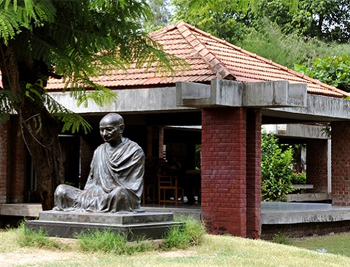
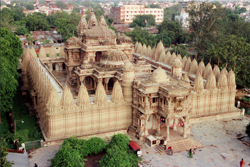
Hutheesing Jain Temple
Hutheesing Jain Temple Located in the city of Ahmedabad in Gujarat, Hutheesing Jain Temple was constructed in 1848 and is dedicated to Lord Dharmanath, the fifteenth Jain Tirthankar. The plan of building a grand temple was initiated by Shet Hathisinh Kesarisinh. Unfortunately, he died before the completion of the temple and hence, his wife had to come forward to complete the formation of Hutheesing Jain Temple.
Designed by the architect Premchand Salat, this wonderful masterpiece costed more than a million dollars at that time which was a huge sum in the 19th century. The sheer dedication of the architect and artisans is reflected over the beautiful walls and designs of the temple. It took around 2 years to complete the overall formation.
Sidi Saiyyed's Mosque
This mosque is one of the most famous mosques of Ahmedabad. The Sidi Saiyyed Mosque, popularly known as Sidi Saiyyed Ni Jali. It was built by Sidi Saiyyed in the retinue of Bilal Jhajar Khan, general in the army of the last Sultan Shams-ud-Din Muzaffar Shah III of the Gujarat Sultanate. It is situated in the heart of the 600-year-old walled city of Ahmedabad. The design of the mosque is entirely in the arcuate system of construction. It is consist of arches, domes, squinches, and vaults. The mosque is set up like a theatre without a fourth wall, celebrated for the intricately carved filigree work on its jalis
The rear wall is filled with square stone pierced panels in geometrical designs. The 20th-century Indologist and art historian Vincent Arthur Smith described these jalis as the “most artistic stone lattice-work to be found anywhere in the world.”
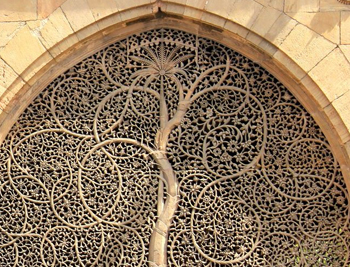
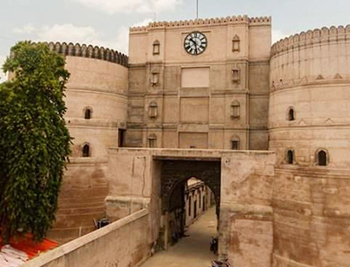
Bhadra Fort
Climb up the Bhadra Fort and get a bird’s eye view of the old city. Built immediately after the founding of Ahmedabad in 1411, Bhadra Fort now houses government offices and a Kali temple. Its gate formed the eastern entrance of the Ahmedabad citadel, which stretched west to the river. From the roof you can check out the imposing structure and views of the surrounding streets. Between the fort and the Teen Darwaja (Triple Gateway) to its east was the Maidan Shahi (Royal Square), where royal processions and polo games took place
Bhadra Fort was built by Ahmed Shah, the founder of the city, in 1411 AD. The fort’s name was taken from the Bhadrakali Temple that stands nearby. The fort was also called Aark fort centuries ago. The British captured the fort in 1817 and used it as a prison until Independence. It was duly renovated in 2014 so that people could get a glimpse of history.
Rani Sipri's Mosque
Rani Sipri’s Mosque also known as Rani Sipri ni Masjid or Masjid-e-nagina, formerly known as Rani Asni’s Mosque, is a medieval mosque in the walled city of Ahmedabad, Gujarat in India. This mosque was commissioned in 1514 by Queen Sipri, the Hindu wife of Mahmud Begada, a sultan who ruled Gujarat.
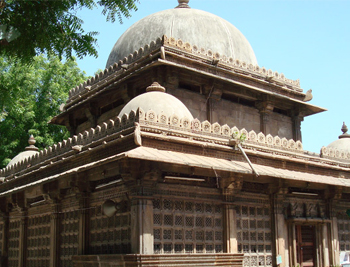
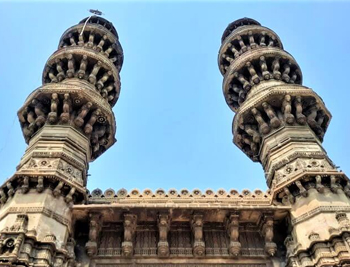
Jhulta Minara
Also known as the Shaking Minarets, they are playful but with a whir of quivering mystery. They have left the best of architects and pioneering design engineers intrigued and in unresolvable wonder. What they cannot unravel is when one minaret is shaken the other begins to vibrate, though the connecting passage between the two remains vibration-free; what causes this vibration is unknown. There are two well-known pairs of Shaking Minarets in Ahmedabad, one located opposite the Sarangpur Darwaja and the other near the Kalupur Railway Station Area. The one near Sarangpur Darwaja is within the vicinity of the Sidi Bashir Mosque built in 1452 AD by Sidi Bashir, a slave of Sultan Ahmed Shah. They are three storeys tall with carved balconies where visitors were once allowed to climb all the way up. The other set of minarets near the Railway Station is taller in height. However, these are not in a very good condition as it is believed that the British had dismantled them to understand the cause of vibrations. They could not resolve the engineering and it was not possible to put them back in their original condition. Demonstrations of the minarets shaking or vibrating are not carried out anymore.
Jama Masjid
Jama Masjid also known as Jumah Mosque or Jami’ Masjid, is a mosque in Ahmedabad, and was built in 1424 during the reign of Ahmad Shah I. The inscription on the central mihrab commemorates the inauguration of the mosque on the 1st Safar A.H. 827 or January 4, 1424 A.D. by Sultan Ahmad Shah I. The mosque lies in the old walled city, and it is situated outside Bhadra Fort area. The old walled city is divided into separate quarters or pols, and the Jami’ Masjid is found on the Gandhi Road. Along the south side of the road, the mosque is a short distance beyond the Teen Darwaza or Tripolia Gate.
The Jama Masjid was the fifth mosque structure built during Ahmed Shah I’s reign. The prior mosques had either been modest in size or were for private use. The Jama Masjid was the complete opposite of its predecessors in that it was a large, grandiose structure. The mosque complex has a large paved courtyard that can be entered from three different directions. The courtyard has an ablution tank in the middle. The west side of the building is home to the prayer hall. The entire mosque is emblematic of what came to be known as Gujarat style architecture.
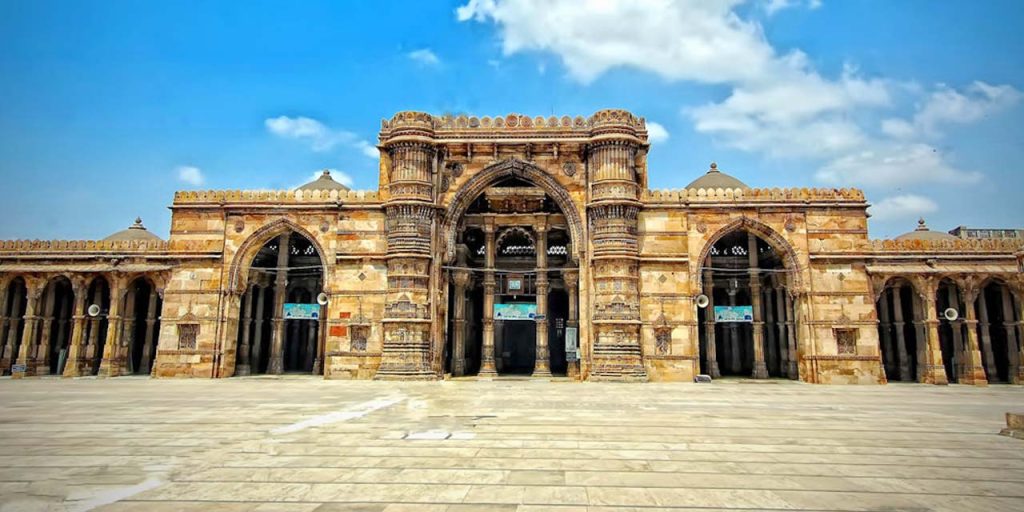
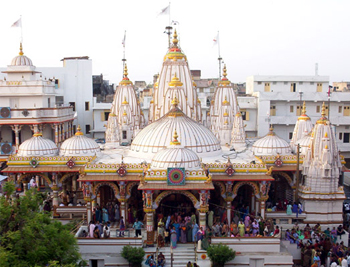
Kalupur Swaminarayan Temple
The origin of the temple goes back to early 19th century when the British had dominance in most parts of India. This is the first temple of the Swaminarayan sect, and was built on the instructions of the founder, Shree Swaminarayan Bhagwan. An officer, Sir Dunlop was so enthralled with activities of Swaminarayan, that on behalf of the government he donated 5,000 acres for the temple to be set up. Once the impressive structure was ready, a 101 gun salute to the temple was organised by him. Different sections of the temple were added subsequently. The main structure was divided into the North Gateway, Nar Narayan Temple, Akshar Bhawan, Rang Mahol and residences for holy women and students. A mansion built by Acharya Maharjshree Keshavprasadji Maharaj came up in 1871.
Vaishnodevi Temple
The Vaishnodevi Temple is a stone-built place of worship located along the Sarkhej Gandhinagar Highway, also known as the Vaishnodevi Circle. The temple architecture is a 50-foot-diameter carve into an artificial rock. The temple, which boasts a 1350-square-foot hall, can accommodate up to 5000 devotees at any given time.
The Vaishnodevi Temple in Ahmedabad is a miniature replica of the Vaishnodevi Temple in Katra, Jammu and Kashmir. It is dedicated to Vaishnodevi, an avatar of Maa Durga, the Hindu female deity. Within the temple, the heads of three other Hindu goddess idols, Lakshmi, Kali, and Saraswati, as well as a Shaiva shrine, are installed.
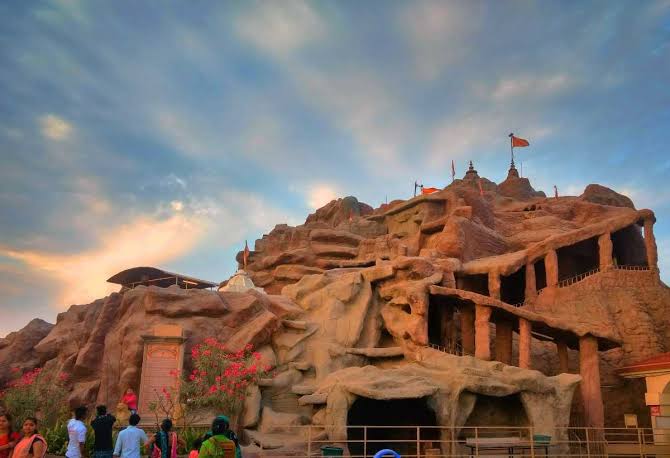
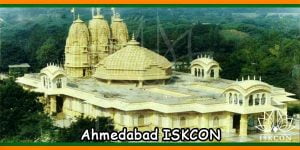
ISKON Temple
At a distance of 13 km from Ahmedabad Junction, ISKCON Temple is a Hindu temple located on Sarkhej-Gandhinagar Highway in Ahmedabad, Gujarat. Also known as Sri Radha Govind Dham, it is one of the top places of pilgrimage in Gujarat and among the famous places to visit in Ahmedabad.
ISKCON Temple in Ahmedabad is dedicated to Lord Krishna and his beloved lover Radha. The temple was opened in 1997 on the orders of A. C. Bhakti Vedanta Swami Prabhupada, the founder of the ISKCON Society. The temple has much significance as it is still considered as the most popular temples in Ahmedabad. The idols of Lord Krishna & Radharani are attractive and many people come here for worshipping Lord Krishna to fulfill their needs.
Sprawling over an area of 4 acres, the architecture of the temple is a blend of Gujarati-Sompura and Rajasthani-Khamira style. The temple features the largest temple rooms in India, which can accommodate around 4000 devotees. One can see intricate marble work, beautiful murals, gorgeous columns, exquisite marble floors and designer walls at the temple. The temple houses the deities of Radha – Govinda, Nitai-Gauri, Rama Sita Lakshman Hanuman, Jagannath Baldev, Sri Nathji, Subhadraji and idols of Srila Prabhupada and Srila Bhaktisiddhanta Saraswati.
Jagannath Temple
The Jagannath Temple is a temple dedicated to the Hindu God Jagannath in the city of Ahmedabad in the Gujarat state of India. The temple located in the Jamalpur locality was established by Sadhu Sarangdasji about 450 years ago. The temple is famous for its annual chariot festival, the Rath Yatra, which is the third most important and largest after the Ratha Yatra at Puri.
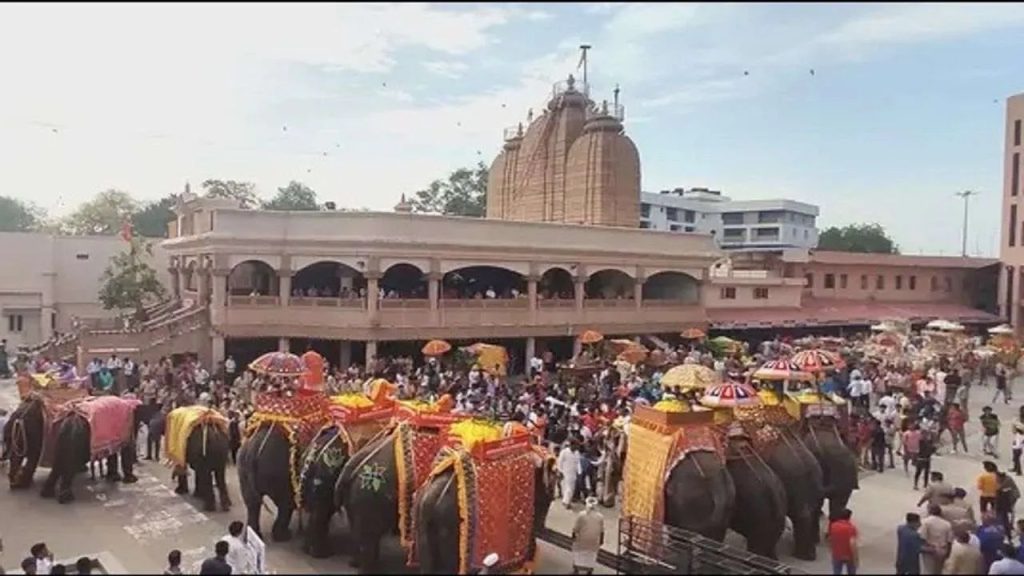
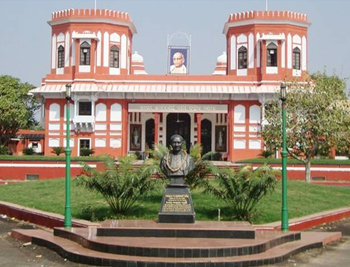
Sardar Patel National Memorial
The Moti Shahi Mahal is a palace built by the Mughal emperor Shahjahan between 1618 and 1622. It now hosts the Sardar Vallabhbhai Patel National Memorial, which is a museum and exhibition centre dedicated to Vallabhbhai Patel located in Shahibaug, Ahmedabad, Gujarat, near Civil Hospital, Ahmedabad.
Adalaj Stepwell
Adalaj Stepwell or Rudabai Stepwell is a stepwell located in the village of Adalaj, close to Gandhinagar city in Gandhinagar district in the Indian state of Gujarat, and considered a fine example of Indian architecture work. It was built in 1498 in the memory of Rana Veer Singh by his wife, Queen Rudadevi
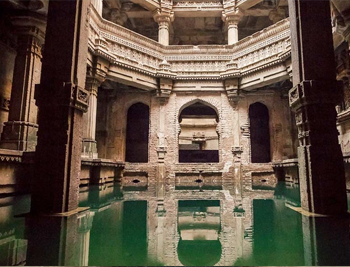
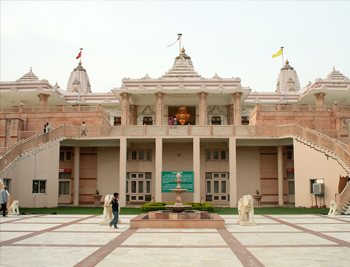
Tri- Mandir, Adalaj
green garden with benches, as well as a beautiful fountain at the center. The Satsang Hall is on the ground floor of the temple and is 31,861 sq ft.
The temple also has an informative museum and mini-theatre on Gnani Purush Param Pujya Dada Bhagwan, around whose vision the Trimandir has been built. His aim was to remove the differences between religions and further to bring religions back to the seat of the Soul. Building a non-sectarian temple was one of the ways that His vision is being fulfilled. The museum has approximately 3,00,000 visitors in a year, and the mini-theatre runs approximately 9,400 shows in Gujarati, Hindi and English, in which there are 2,22,000 viewers.
Dada Harir Stepwell
The stepwell was built in 1485 by Dhai Harir, a household lady of Mahmud Begada according to the Persian inscription in the stepwell. She was the superintendent of the royal harem.
Dhai Harir built a mosque and a tomb in which she was buried. The well bears two inscriptions, one in Sanskrit on the south, and one in Arabic on the north wall, of the first gallery.
The Arabic writing reads: This holy and wholesome water; the splendid travellers’ rest-house enclosed on four sides by carved and painted walls, and a grove of fruit trees with their fruit, a well, and a pool of water for the use of man and heist, were built in the reign of the Sultan of the Sultans of the age, established by the grace of God and of the faith, Abul Fath Mahmud Shah, son of Muhammad Shah, son of Ahmed Shah, son of Muhammad Shah, son of Muzaffar Shah the Sultan, may God keep his kingdom. Dated the metropolis of the kingdom the 2nd of Jamadi-ul-awwal in the 26th year of the reign.
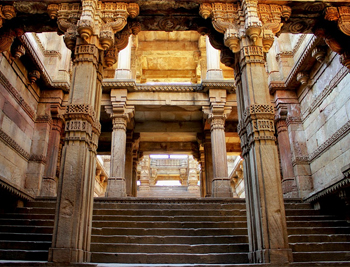
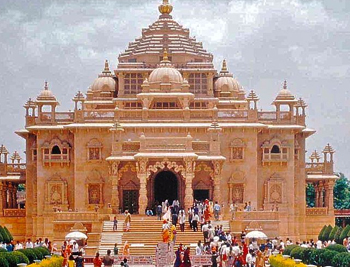
Akshardham
Riverfront Flower Park
To witness the beauty of the nature, Flower Park offers variety of flowers to enthuse the feeling of joy and happiness in oneself. There are more than 72 varieties of species in this Garden full of flowers located near Ellisbridge. The unique feature of this Garden is that it has been differentiated on the basis of fragrance, theme, leaf color and many other things. This 3.85 Hectare park also has a valley of flowers to offer many different flowers at one place.
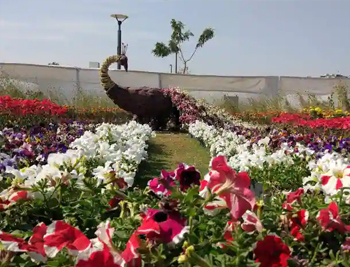
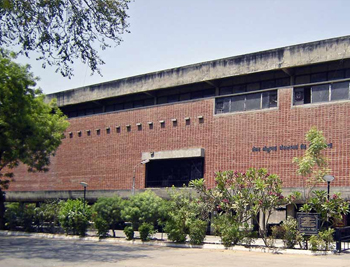
Sanskar Kendra (Paldi Museum)
green garden with benches, as well as a beautiful fountain at the center. The Satsang Hall is on the ground floor of the temple and is 31,861 sq ft.
Sanskar Kendra is a museum at Ahmedabad, India, designed by the architect Le Corbusier. It is a city museum depicting history, art, culture and architecture of Ahmedabad. Another Patang Kite Museum is there which includes a collection of kites, photographs, and other artifacts
Kankaria Lake
Kankaria Lake is the second largest lake in Ahmedabad, Gujarat, India. It is located in the south-eastern part of the city, in the Maninagar area. It was completed in 1451 during the reign of Sultan Qutb-ud-Din Ahmad Shah II though its origin is placed in the Chaulukya period sometimes. A lakefront is developed around it, which has many public attractions such as a zoo, toy train, kids city, tethered balloon ride, water rides, water park, food stalls, and entertainment facilities. The lakefront was revamped in 2007–2008. Kankaria Carnival is a week-long festival held here in the last week of December. Many cultural, art, and social activities are organised during the carnival.
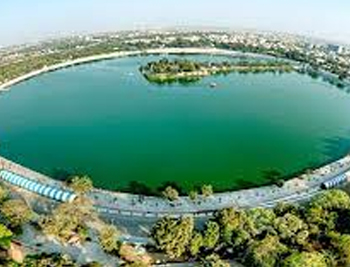
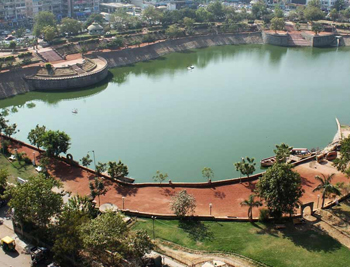
Vastrapur Lake
Vastrapur Lake is situated in western part of Ahmedabad. It is officially named after Narsinh Mehta. The lake was beautified by the AMC after 2002 and has since become a popular spot in the city. Everyday, many people visit this lake. It currently boasts an open-air theater and children’s park.



